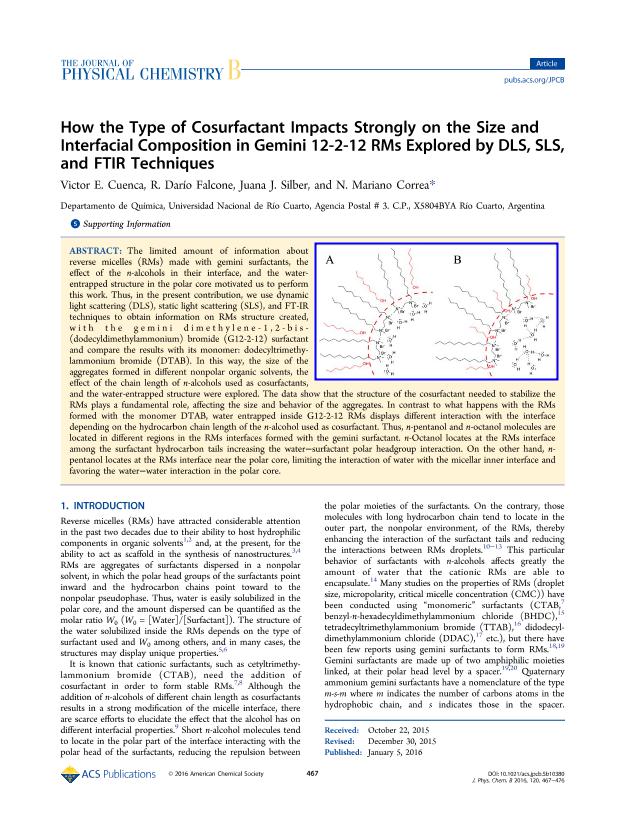Mostrar el registro sencillo del ítem
dc.contributor.author
Cuenca, Victor Ezequiel

dc.contributor.author
Falcone, R. Darío
dc.contributor.author
Silber, Juana J.
dc.contributor.author
Correa, Nestor Mariano

dc.date.available
2022-11-30T18:01:37Z
dc.date.issued
2016-01
dc.identifier.citation
Cuenca, Victor Ezequiel; Falcone, R. Darío; Silber, Juana J.; Correa, Nestor Mariano; How the Type of Cosurfactant Impacts Strongly on the Size and Interfacial Composition in Gemini 12-2-12 RMs Explored by DLS, SLS, and FTIR Techniques; American Chemical Society; Journal of Physical Chemistry B; 120; 3; 1-2016; 467-476
dc.identifier.issn
1520-6106
dc.identifier.uri
http://hdl.handle.net/11336/179605
dc.description.abstract
The limited amount of information about reverse micelles (RMs) made with gemini surfactants, the effect of the n-alcohols in their interface, and the water-entrapped structure in the polar core motivated us to perform this work. Thus, in the present contribution, we use dynamic light scattering (DLS), static light scattering (SLS), and FT-IR techniques to obtain information on RMs structure created, with the gemini dimethylene-1,2-bis(dodecyldimethylammonium) bromide (G12-2-12) surfactant and compare the results with its monomer: dodecyltrimethylammonium bromide (DTAB). In this way, the size of the aggregates formed in different nonpolar organic solvents, the effect of the chain length of n-alcohols used as cosurfactants, and the water-entrapped structure were explored. The data show that the structure of the cosurfactant needed to stabilize the RMs plays a fundamental role, affecting the size and behavior of the aggregates. In contrast to what happens with the RMs formed with the monomer DTAB, water entrapped inside G12-2-12 RMs displays different interaction with the interface depending on the hydrocarbon chain length of the n-alcohol used as cosurfactant. Thus, n-pentanol and n-octanol molecules are located in different regions in the RMs interfaces formed with the gemini surfactant. n-Octanol locates at the RMs interface among the surfactant hydrocarbon tails increasing the water-surfactant polar headgroup interaction. On the other hand, n-pentanol locates at the RMs interface near the polar core, limiting the interaction of water with the micellar inner interface and favoring the water-water interaction in the polar core.
dc.format
application/pdf
dc.language.iso
eng
dc.publisher
American Chemical Society

dc.rights
info:eu-repo/semantics/openAccess
dc.rights.uri
https://creativecommons.org/licenses/by-nc-sa/2.5/ar/
dc.subject
GEMINI SURFACTANT
dc.subject
REVERSE MICELLE
dc.subject
COSURFACTANT
dc.subject.classification
Físico-Química, Ciencia de los Polímeros, Electroquímica

dc.subject.classification
Ciencias Químicas

dc.subject.classification
CIENCIAS NATURALES Y EXACTAS

dc.title
How the Type of Cosurfactant Impacts Strongly on the Size and Interfacial Composition in Gemini 12-2-12 RMs Explored by DLS, SLS, and FTIR Techniques
dc.type
info:eu-repo/semantics/article
dc.type
info:ar-repo/semantics/artículo
dc.type
info:eu-repo/semantics/publishedVersion
dc.date.updated
2022-11-30T12:07:20Z
dc.journal.volume
120
dc.journal.number
3
dc.journal.pagination
467-476
dc.journal.pais
Estados Unidos

dc.journal.ciudad
Washington
dc.description.fil
Fil: Cuenca, Victor Ezequiel. Universidad Nacional de Río Cuarto. Facultad de Ciencias Exactas Fisicoquímicas y Naturales. Departamento de Química; Argentina. Consejo Nacional de Investigaciones Científicas y Técnicas. Centro Científico Tecnológico Conicet - Córdoba; Argentina
dc.description.fil
Fil: Falcone, R. Darío. Universidad Nacional de Río Cuarto. Facultad de Ciencias Exactas Fisicoquímicas y Naturales. Departamento de Química; Argentina
dc.description.fil
Fil: Silber, Juana J.. Universidad Nacional de Río Cuarto. Facultad de Ciencias Exactas Fisicoquímicas y Naturales. Departamento de Química; Argentina
dc.description.fil
Fil: Correa, Nestor Mariano. Consejo Nacional de Investigaciones Científicas y Técnicas. Centro Científico Tecnológico Conicet - Córdoba; Argentina. Universidad Nacional de Río Cuarto. Facultad de Ciencias Exactas Fisicoquímicas y Naturales. Departamento de Química; Argentina
dc.journal.title
Journal of Physical Chemistry B

dc.relation.alternativeid
info:eu-repo/semantics/altIdentifier/url/http://pubs.acs.org/doi/abs/10.1021/acs.jpcb.5b10380
dc.relation.alternativeid
info:eu-repo/semantics/altIdentifier/doi/http://dx.doi.org/10.1021/acs.jpcb.5b10380
Archivos asociados
